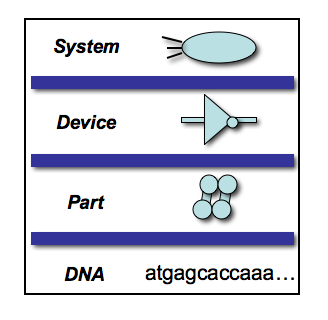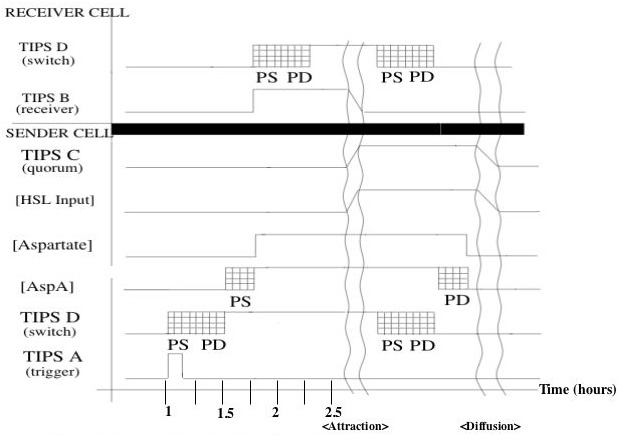2020(S09) Lecture:week 7: Difference between revisions
| Line 82: | Line 82: | ||
=<center>Week 7 Thursday</center>= | =<center>Week 7 Thursday</center>= | ||
We've been working hard this week to move between the System and Device levels of an abstraction hierarchy and today we'll drop down one more level to think about the parts that make up a device. The device we'll consider is a ring oscillator, aka "blinker." | We've been working hard this week to move between the System and Device levels of an abstraction hierarchy and today we'll drop down one more level to think about the parts that make up a device. The device we'll consider is a ring oscillator, aka "blinker." | ||
==Challenge:<font color = blue>Abstraction: Devices to Parts | ==Challenge:<font color = blue>Abstraction in action: Devices to Parts</font color>== | ||
===Part 1: Four-part inverter=== | |||
Recall the device-level system diagram for the Eau d'coli project. | |||
**NOTE: This activity features an "All questions answered" work environment. Ask questions. | ===Part 2: Let's make a switch=== | ||
**HINT: Your DNA synthesis budget may not be large enough to pay for synthesis of all the parts needed to make | Working in your project teams, develop a design for '''a genetically encoded switch that works through the expression of a regulatory RNA'''. Your team's design should include (a) a high level system diagram, (b) a full list of devices and parts, (c) a source for all the necessary DNA parts (be it research lab or synthesis company), and (d) a plan for testing the most important components of your switch. You have 1 hour. Your team's budget for this project is $1000. | ||
**HINT: Your team may not have enough time to design everything needed to make | **NOTE: This activity features an "All questions answered" work environment. Ask lots of questions. | ||
**HINT: Your DNA synthesis budget may not be large enough to pay for synthesis of all the parts needed to make the switch. | |||
**HINT: Your team may not have enough time to design everything needed to make the RNA-based switch. | |||
**HINT: Spend 2 minutes right now thinking about all the things that need to come together over the next hour for your team to be successful. | **HINT: Spend 2 minutes right now thinking about all the things that need to come together over the next hour for your team to be successful. | ||
**QUESTION: How will you check that everybody on your team understands what is going on? | |||
Revision as of 12:55, 15 March 2009
<html> <style>#en2020 a {color:black;}</style> </html>

|
| Home | Lecture and Studio schedule |
20.902 Reading Schedule | |
| Week 1 Week 2 Week 3 Week 4 Week 5 Week 6 Week 7 | |||
| Week 8 Week 9 Week 10 Week 11 Week 12 Week 13 Week 14 | |||
| Expectations | Guidelines: 3 Ideas Presentation | Guidelines: Tech Spec Review | Guidelines: Final Presentations |
| Team Building Resources | Teacher Resources |
Week 7 Tuesday
Over the next few weeks we will spend nearly all of our lecture and studio time specifying these aspects of your project:
- a system overview
- a device list
- a timing diagram
- a parts list
Be ready to revise what seemed like completed aspects of your project as you learn more about what's available and how things work. Design/revise/design/revise/design/revise....that what the next few weeks will be all about...
Project Selection Status?
- Brief report of each team's project selection status.
- oncoCURES
- ENERGYneering
- TrashToTreasure
- Neurohackers
- Growth!
- BoostTheBody
Challenge: System Overview
Part 1: Flip Books
- Here's a warm up challenge to show what is meant by a system overview
- Working independently, you should take 10 minutes to sketch a process into a flip book (materials to be provided). The process you choose to illustrate is up to you. It can be a plant growing, a house of cards being built, or a happy message appearing letter by letter on a computer screen. What you choose is limited only by the number of pages in your book, your ability to draw, and the limited amount of time you're given to complete this challenge. 10 minutes only!
- Before we move on to the next part of today's class we'll hear from some of the flip-book drawers to learn what worked well and what didn't about this way to overview and illustrate a system
Part 2: Bacterial Buoy
- Next you and your project team will generate a system overview for the Melbourne 2007 iGEM "coliform" project.
- The Melbourne team wanted to build a 3D, floating mass of bacteria that adhered to one another when the cells detected both blue and red light. In other words: at the intersection of an incoming red light beam and blue light beam, a solution of bacteria would clump and remain suspended in its growth media.

- As a class we'll watch the first 5 minutes of the Melbourne team's iGEM presentation.
- Next your project team should work out a system overview for the coliform project. You can get an unused flip book (or use the back of one from the warmup exercise), or come up with some other mechanism of illustrating how the Melbourne team's system would work. You should not spend more than 10 minutes on this activity. When you are done, delegate someone to explain what you've done as a team and what questions arose as you worked. Then you and your team can get right to work on the last thing planned for today's lecture.
|
As a class we'll consider the value of having a clear system overview:
|
Part 3: Your Idea Here
Finally, take the rest of today's lecture time to illustrate or specify the system overview of your team's project. You do not need to make a flip book unless you find this a useful way to brainstorm and define the outstanding issues. Ideally some version of the system overview you generate today will be shown in your Tech Spec Review.
Before tomorrow's studio time
If there are outstanding issues related to the system overview for your project be sure everyone on your team knows how you'll solve the issue(s) and make a plan to come to studio tomorrow with materials for finishing the system overview and getting good work done on the device list and, perhaps the timing diagram.
Week 7 Studio
Are there tools or methods for breaking down a complicated problem into simpler parts?
- Watch the Abstraction animation from BioBuilder
- Walk through one sample abstraction hierarchy that may guide synthetic biology
This abstraction hierarchy is modified from one of Drew Endy's slides. It gives us a framework for how to intentionally engineer various aspects of biological systems.


Part 1: Abstraction in action: Systems to Devices
first up: Arsenic detector

next: Bacterial buoy
Consider again the coliform project from the Melbourne 2007 iGEM team. The team listed six devices they needed to realize their idea:
- a red light sensor
- a blue light sensor
- an AND gate to trigger a cellular behavior when both lights are present
- a GFP reporter to monitor easily/quantifiably the AND gate's function
- expression of adhesive proteins under the control of the AND gate
- a gas vesicle expression cassette to produce neutrally buoyant bacteria

After just 5 minutes we'll see the device level system diagrams that you've drawn for this system and discuss any outstanding questions or concerns.
and finally: Polkadorks
Let's try a more dynamic system. Check out the Polkadorks animation.
- As a class we'll
- describe the system in plain language, then
- list the devices needed to implement the system
- Then as a team you'll have 10 minutes to draw a device-level system diagram.
- Finally, as a class, we'll look at the timing diagram that the 2004 IAP team wrote.

Part 2: Get busy!
Start applying these ideas to your team's project. You can work on a device list, a device-level system diagram and a timing diagram if you're ready. Be sure to keep your project notebook up to date and help keep each other great.
Week 7 Thursday
We've been working hard this week to move between the System and Device levels of an abstraction hierarchy and today we'll drop down one more level to think about the parts that make up a device. The device we'll consider is a ring oscillator, aka "blinker."
Challenge:Abstraction in action: Devices to Parts
Part 1: Four-part inverter
Recall the device-level system diagram for the Eau d'coli project.
Part 2: Let's make a switch
Working in your project teams, develop a design for a genetically encoded switch that works through the expression of a regulatory RNA. Your team's design should include (a) a high level system diagram, (b) a full list of devices and parts, (c) a source for all the necessary DNA parts (be it research lab or synthesis company), and (d) a plan for testing the most important components of your switch. You have 1 hour. Your team's budget for this project is $1000.
- NOTE: This activity features an "All questions answered" work environment. Ask lots of questions.
- HINT: Your DNA synthesis budget may not be large enough to pay for synthesis of all the parts needed to make the switch.
- HINT: Your team may not have enough time to design everything needed to make the RNA-based switch.
- HINT: Spend 2 minutes right now thinking about all the things that need to come together over the next hour for your team to be successful.
- QUESTION: How will you check that everybody on your team understands what is going on?